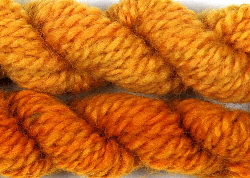also known as Plains Coreopsis or Calliopsis
1)  Biology of Coreopsis Biology of Coreopsis
2) Growing Coreopsis
3) Harvesting with Coreopsis
4) Dyeing with Coreopsis
Biology of Coreopsis
Coreopsis belongs to the Compositae family and is native to North America. It is an annual growing up to 100 cm but the young plants, with their thin and stringy leaves, can be confused with weeds. From June, a mass of small flowers, often brilliant yellow with maroon or brown centers, appear on slender stems. The hermaphrodite flowers are pollinated by bees and the seeds ripen from June to October.
Growing Coreopsis
This is an easy plant to grow. Sow the small slender seeds indoors a few weeks before last frost and transplant when seedlings are about 2 inches (5 cm) high. According to Buchanan, two dozen plants produce enough flowers in a season to dye a pound of wool or silk.
Coreopsis will thrive on any soil, but the plants need full sun. The plants grow quickly and start to flower at about 8 to 12 weeks, each plant bearing hundreds of flowers. Established plants are drought resistant. Keeping them well watered, however, prevents the flowers from going to seed too soon.
You can keep a flower-bed going for years, as coreopsis self seeds regularly. Otherwise you could save a few ripe seed heads. If you have saved sufficient seeds you can sow them outdoors directly in the flowering site.
Harvesting Coreopsis
Pick the flowers either in full bloom or as they begin to fade. Harvesting the flowers before they set seed causes even more flowers to bloom. Cut the plants back to encourage a second flowering. You can use the flowers fresh or dry them until you have enough for a dye bath. Store dry flowers in a paper bag or in a shoe box; the flowers will go mouldy if kept in a plastic bag.
Dyeing with Coreopsis
The flowers yield yellows, oranges and browns and several species of coreopsis can be used for dyeing. Liles suggests using about 800ml of fresh flowers or 400ml dried flowers for 100g of fibre; you could also try using the same weight of wool and flowers. Coreopsis produces better colours on wool or silk, and it is not recommended for dyeing cotton and other vegetable fibres.
If you have time, soak the flowers overnight, and then simmer them the next day. Dean says that a coreopsis dye bath is sensitive to ph; a small amount of acid lemon juice will change the colour towards yellow and a pinch of soda ash will bring out the reds.
Top of Page
|